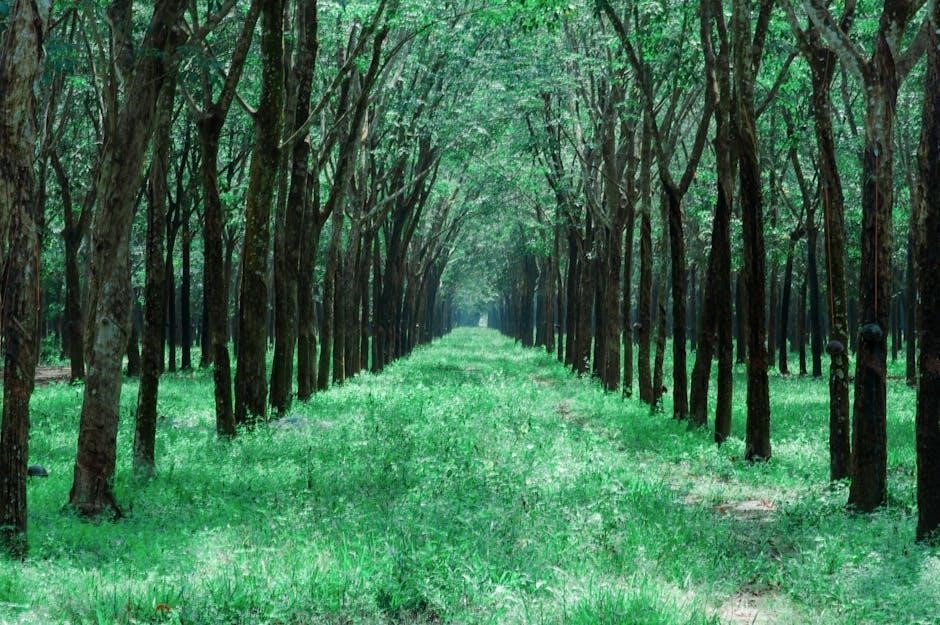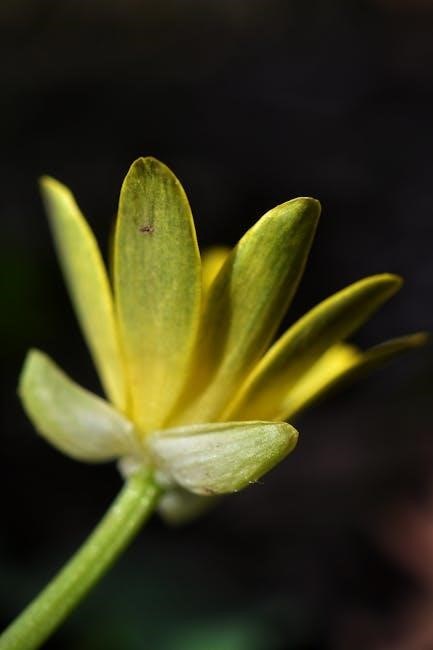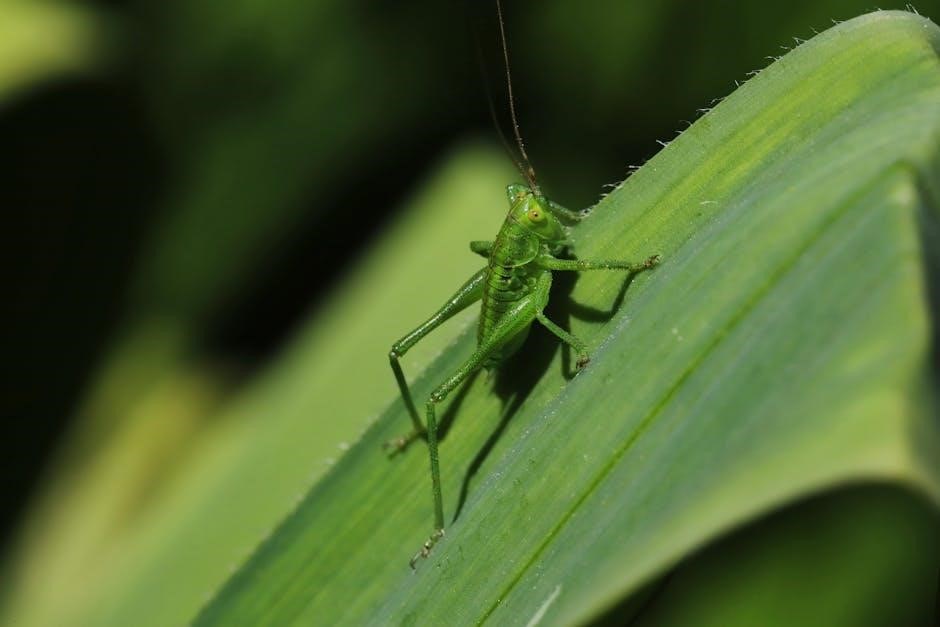
Welcome to your comprehensive Zone 6 planting guide! This detailed resource helps gardeners optimize their growing season with monthly schedules, climate insights, and expert tips for success.
1.1 Overview of USDA Hardiness Zone 6
USDA Hardiness Zone 6 covers a wide geographic area, including parts of 30 states and even Alaska. It is characterized by moderate winters and warm summers, with average annual extreme temperatures ranging from -10°F to 70°F. This zone offers a long enough growing season to support a variety of plants, including hardy perennials, vegetables, and fruits. Understanding Zone 6’s climate and frost dates is essential for gardeners to plan effectively, ensuring plants thrive in its unique conditions. This zone’s versatility makes it ideal for diverse gardening strategies and plant selections.
1.2 Importance of Understanding Your Planting Zone
Understanding your planting zone is vital for gardening success. It helps you choose plants adapted to your local climate, ensuring they thrive in your region’s conditions. Zone 6’s moderate winters and warm summers allow for a diverse range of plants, but timing is critical. Knowing your zone enables you to plant at the right time, avoid frost damage, and maximize the growing season. This knowledge also guides seed starting, transplanting, and harvest planning, ensuring optimal results. Whether you’re growing vegetables, flowers, or shrubs, understanding Zone 6’s unique characteristics is key to a productive and flourishing garden.

Understanding Zone 6 Climate and Frost Dates

Zone 6 has moderate winters and warm summers, with frost dates shaping planting strategies. Knowing these dates helps avoid frost damage and maximizes the growing season effectively.
2.1 First and Last Frost Dates in Zone 6
In Zone 6, the average first frost date is around mid-April, while the last frost date typically occurs in mid-September. These dates are crucial for gardeners, as they determine when it’s safe to plant warm-season crops outdoors and when to harvest cool-season crops before winter. Knowing these dates helps avoid frost damage to sensitive plants. For example, tomatoes and peppers should be planted after the last frost, while spinach and kale can tolerate light frosts. Planning around these dates ensures optimal growth and productivity for both annuals and perennials in Zone 6 gardens.
2.2 How Climate Affects Planting Schedules
Zone 6’s moderate climate, with warm summers and cold winters, significantly influences planting schedules. The region’s average growing season lasts around 180 days, allowing for a wide variety of crops. Temperature fluctuations dictate when to plant, as sensitive crops must avoid early spring frosts and late summer heatwaves. Soil temperature also plays a role, as seeds like tomatoes and corn germinate best in warmer soils. Additionally, Zone 6’s rainfall patterns and occasional droughts require gardeners to adjust planting times and irrigation strategies. Understanding these climate factors ensures plants thrive during their optimal growing periods in Zone 6 gardens.

Monthly Planting Schedule for Zone 6
Zone 6’s monthly planting schedule guides gardeners through seasonal planting, ensuring optimal growth and harvest. Each month offers specific planting opportunities tailored to the climate.
3.1 January: Planning and Preparing for the Growing Season
January is the ideal time to plan and prepare for Zone 6’s upcoming growing season. Review last year’s garden performance and create a detailed planting calendar. Order seeds and supplies, ensuring they suit Zone 6’s climate. Begin sketching your garden layout, considering crop rotation and companion planting. Clean and sharpen gardening tools to ensure readiness. Although the ground is frozen, start indoor seedlings like onions or leeks. If weather permits, apply compost or mulch to beds. This month sets the foundation for a successful growing year in Zone 6.
3.2 February: Starting Seeds Indoors

February is a critical month for Zone 6 gardeners to start seeds indoors, ensuring a head start on the growing season. Begin with cool-season crops like broccoli, kale, and spinach, as well as tomatoes and peppers, which require a longer germination period. Use seed trays or small pots with high-quality potting mix. Provide adequate light, such as grow lights, and maintain consistent temperatures between 65-75°F. Keep soil moist but not waterlogged to prevent mold. This step prepares plants for transplanting outdoors after the last frost date, typically in late April or early May for Zone 6.
3.3 March: Early Spring Planting
March marks the beginning of early spring planting in Zone 6. As the soil begins to thaw, focus on preparing beds by loosening the ground and incorporating compost or well-rotted manure. Plant cool-season crops like spinach, radishes, and peas directly into the ground once the soil is workable. Hardy root vegetables such as carrots and beets can also be sown. Check soil temperature to ensure it’s above freezing for optimal germination. Avoid planting warm-season crops until later, as they require warmer temperatures. Early planting in March sets the stage for a thriving and productive garden in Zone 6.
3.4 April: Transitioning to Warm-Weather Crops
April in Zone 6 signals the transition to warm-weather crops. As temperatures rise, focus on hardening off seedlings like tomatoes and peppers before transplanting them outside. Direct sow crops such as beans, cucumbers, and zucchini once the soil has warmed to at least 60°F. Continue planting cool-season crops like lettuce and carrots, but prioritize warm-season varieties as the last frost date approaches. Rotate crops to maintain soil health and prevent pests. April is also an ideal time to fertilize beds and mulch to retain moisture and suppress weeds. Proper timing ensures a smooth shift into the growing season.
3.5 May: Direct Sowing and Transplanting
May is a busy month in Zone 6, with warm weather crops thriving. Direct sow seeds for beans, cucumbers, squash, and corn once the soil has warmed to at least 60°F. Transplant tomatoes, peppers, and eggplants outside after hardening them off. Ensure spacing matches mature plant sizes to prevent overcrowding. Water thoroughly after planting and maintain consistent moisture. Mulch around plants to retain moisture and suppress weeds. Monitor soil temperature, as warmer soils promote faster germination. This month sets the foundation for a productive summer harvest, so proper timing and care are essential for successful growth.
3.6 June: Summer Gardening Tips

June marks the peak of summer in Zone 6, with warm temperatures ideal for growth. Water plants deeply but avoid overwatering, which can lead to root rot. Mulch around plants to retain moisture and suppress weeds. Provide afternoon shade for heat-sensitive crops using row covers or shade cloth. Fertilize vegetables and flowers with a balanced fertilizer to promote healthy growth. Keep an eye out for pests like aphids and hornworms, using organic controls when necessary. Deadhead flowers to encourage blooming and prune shrubs for shape and airflow. Regular maintenance now ensures a thriving summer garden.
3.7 July: Maintaining and Harvesting Crops
July is prime time for harvesting in Zone 6, with many crops reaching maturity. Regularly check vegetables like tomatoes, peppers, and cucumbers for ripeness to encourage continuous production. Keep beds consistently watered, but avoid overwatering, which can lead to disease. Mulch around plants to retain moisture and suppress weeds. Monitor for pests like aphids, squash bugs, and hornworms, treating promptly if necessary. Thin fruiting plants to allow proper growth and air circulation. Fertilize lightly to sustain production, and consider side-dressing with compost. Weed regularly to prevent competition for nutrients. Harvest flowers to promote blooming and enjoy the peak of summer abundance.
3.8 August: Preparing for Fall Planting
August is a key month for preparing your Zone 6 garden for fall crops. Start by cleaning up beds from summer harvests and composting debris to enrich the soil. Order seeds or seedlings for cool-season crops like broccoli, kale, and spinach. Assess which summer plants are still productive and replace those that are done. Proper timing is crucial, as fall crops need sufficient time to mature before the first frost. Use planting charts to schedule accurately, ensuring a successful transition to fall gardening.
3.9 September: Cool-Weather Crops
September in Zone 6 is ideal for planting cool-weather crops that thrive in cooler temperatures. Start by direct sowing spinach, kale, and radishes, or transplant broccoli and cauliflower seedlings. Ensure the soil is well-prepared, with adequate organic matter. Most cool-weather crops require about 50 to 60 days to mature before the first frost. Keep the soil consistently moist and control weeds to promote healthy growth. This period also allows for a second harvest of crops like green beans or peas. Proper planning ensures a bountiful fall garden in Zone 6.
3.10 October: Final Harvests and Garden Cleanup
October in Zone 6 marks the end of the growing season, with a focus on final harvests and garden cleanup. Collect remaining crops like squash, apples, and root vegetables before the first frost. Remove dead or diseased plants to prevent pests and diseases from overwintering. Add compost to enrich the soil for next year. Protect sensitive perennials with mulch or straw. Clean and store gardening tools, and plan for spring by planting bulbs like tulips or daffodils. Proper cleanup ensures a healthy and productive garden come springtime in Zone 6.
3.11 November: Planting Bulbs and Winter Preparation
November in Zone 6 is ideal for planting spring-flowering bulbs like tulips, daffodils, and hyacinths. Choose healthy bulbs and plant them in well-draining soil before the ground freezes. Apply a layer of mulch or straw to protect the soil from extreme cold. Prepare for winter by insulating sensitive plants and draining garden hoses. Store gardening tools and equipment to protect them from harsh weather. This season is also a good time to review your garden’s performance and plan improvements for the upcoming year in Zone 6.
3.12 December: Planning for the Next Year
December is a great time to reflect on your Zone 6 garden’s performance and plan for the upcoming year. Review what worked well and what didn’t, taking notes for future improvements. Organize your garden tools and storage areas to ensure everything is clean and ready for spring. Order seeds and supplies early to avoid shortages. Create a detailed planting calendar tailored to Zone 6’s climate and frost dates. Budget for new plants or equipment to enhance your garden. This preparation ensures a successful and stress-free growing season ahead in Zone 6.

Best Plants for Zone 6 Gardens
Zone 6 gardens thrive with an array of hardy plants. Vegetables like tomatoes and peppers grow well in the warm summers, while perennials such as daylilies and coneflowers provide year-round beauty.
4.1 Vegetables That Thrive in Zone 6
Zone 6 offers a moderate climate, making it ideal for growing a wide variety of vegetables. Tomatoes, peppers, and cucumbers excel in the warm summers, while cool-season crops like broccoli, spinach, and kale thrive in spring and fall. Root vegetables such as carrots, beets, and radishes also perform well. Zucchini, green beans, and squash are reliable choices for summer harvests; Additionally, Zone 6 gardeners can successfully grow lettuce, peas, and onions. Proper planting times aligned with frost dates ensure optimal growth and productivity for these vegetables.
- Tomatoes
- Peppers
- Cucumbers
- Broccoli
- Spinach
- Kale
- Carrots
- Beets
- Radishes
- Zucchini
- Green beans
- Squash
- Lettuce
- Peas
- Onions
4.2 Flowers and Ornamental Plants for Zone 6
Zone 6’s temperate climate supports a variety of vibrant flowers and ornamental plants. Perennials like peonies, daylilies, and coneflowers thrive in its moderate conditions; Annuals such as petunias, marigolds, and zinnias add color and vibrancy to gardens. Spring-flowering bulbs like tulips and daffodils are ideal for early blooms, while hydrangeas and roses provide stunning summer displays. Ornamental grasses and sedums also excel, offering texture and interest in both warm and cool seasons. Planting these species at the right time ensures they flourish in Zone 6’s climate.
- Peonies
- Daylilies
- Coneflowers
- Petunias
- Marigolds
- Zinnias
- Tulips
- Daffodils
- Hydrangeas
- Roses
- Ornamental grasses
- Sedums

Gardening Tips for Zone 6 Success
Mastering Zone 6 gardening involves optimizing soil health, timing plantings according to frost dates, and using companion planting to enhance growth and deter pests naturally, ensuring a thriving garden year-round.
5.1 Soil Preparation and Care
Preparing your soil is key to a thriving Zone 6 garden. Test your soil pH and amend it if necessary, as most plants prefer a slightly acidic to neutral soil (6.0–7.0). Add organic matter like compost or well-rotted manure to improve soil structure and fertility. Ensure proper drainage and aeration by loosening compacted soil. Avoid over-tilling, as it can disrupt beneficial soil microorganisms. Seasonally, replenish nutrients in spring with a balanced fertilizer and mulch to retain moisture and suppress weeds. In fall, incorporate compost or manure to enrich the soil for the next growing season.
5.2 Companion Planting Strategies
Companion planting enhances growth, deters pests, and optimizes space in Zone 6 gardens. Pair marigolds with tomatoes to repel nematodes, or basil with tomatoes to improve flavor and reduce pests. Plant corn, beans, and squash together for a traditional, mutually beneficial arrangement. Avoid placing members of the Brassica family (like broccoli) near strawberries, as they can stunt growth. Radishes can deter cucumber beetles, while nasturtiums repel aphids from vegetables. These strategies promote a balanced ecosystem, reducing the need for pesticides and fostering a healthier, more productive garden.

Tools and Resources for Zone 6 Gardeners
Essential tools include trowels, gloves, and watering cans. Resources like planting charts, gardening apps, and soil test kits help Zone 6 gardeners succeed.
6.1 Planting Charts and Calendars
Planting charts and calendars are indispensable tools for Zone 6 gardeners. These resources provide detailed timelines for planting vegetables, flowers, and ornamental plants based on frost dates and climate trends. By following these guides, gardeners can optimize planting schedules to ensure optimal growth and yield. Charts often include specific dates for starting seeds indoors, transplanting, and direct sowing. Calendars may also highlight peak harvest times and soil preparation tips. Using these tools helps gardeners align their efforts with Zone 6’s unique growing conditions, ensuring a successful and productive gardening experience throughout the year.
6.2 Apps and Online Tools for Garden Planning
Apps and online tools have revolutionized garden planning for Zone 6 gardeners. Platforms like Garden Plan Pro and Happy Gardening offer interactive layouts to design gardens and track planting schedules. Apps such as Seed Saver’s Exchange provide seed-starting calendars tailored to Zone 6’s frost dates. Online tools often include features like weather tracking, soil preparation tips, and pest management advice. These resources help gardeners optimize their planting strategies and stay informed about local growing conditions. By leveraging these tools, Zone 6 gardeners can make informed decisions, ensuring a thriving and productive garden throughout the growing season.
7.1 Maximizing Your Zone 6 Garden Productivity
To maximize productivity in your Zone 6 garden, focus on soil preparation, proper watering, and selecting plants suited to the local climate. Adhere to the planting schedule, ensuring vegetables, flowers, and ornamental plants are sown at optimal times. Incorporate companion planting to enhance growth and deter pests. Regularly maintain your garden through weeding, mulching, and monitoring for diseases. By following these strategies and staying attuned to seasonal changes, you can achieve a thriving, productive garden that makes the most of Zone 6’s growing conditions.

Appendix: Zone 6 Planting Calendar
This appendix provides a printable monthly planting calendar for Zone 6, detailing specific crops and tasks for each season, ensuring optimal gardening success.
8.1 Printable Monthly Planting Chart
A printable monthly planting chart for Zone 6 provides a visual guide to track planting tasks, ensuring gardeners stay organized year-round. This chart outlines specific crops, planting dates, and care tips tailored to Zone 6’s climate. It includes space for notes, allowing gardeners to personalize their plans based on weather patterns and soil conditions. By following this chart, gardeners can maximize their growing season, avoid common mistakes, and enjoy a bountiful harvest. It’s an essential tool for both new and experienced gardeners, offering a clear and concise roadmap for success in Zone 6 gardens.